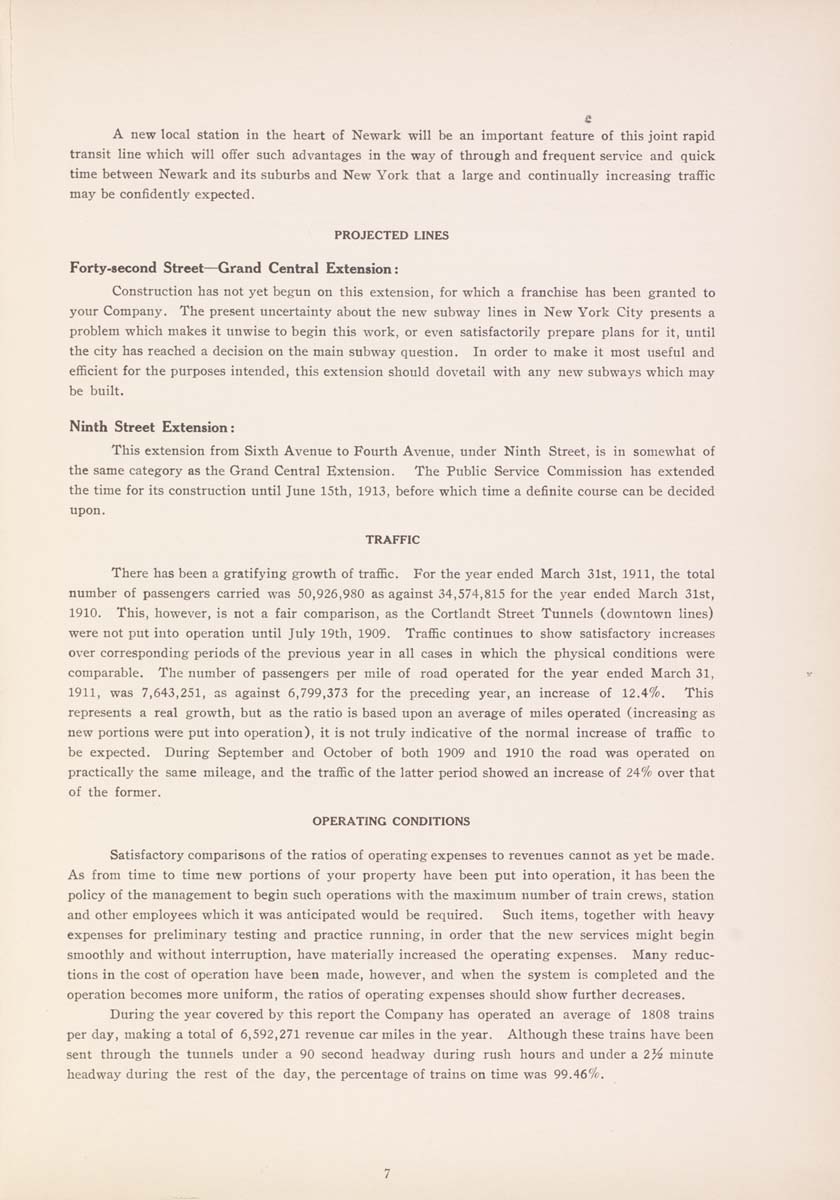Annual report of Hudson & Manhattan Railroad Company
(New York, N.Y. : Hudson and Manhattan Railroad Company )
|
||
|
|
|
|
| 1911: Page 7 |

A new local station in the heart of Newark will be an important feature of this joint rapid transit line which will offer such advantages in the way of through and frequent service and quick time between Newark and its suburbs and New York that a large and continually increasing traffic may be confidently expected. PROJECTED LINES Forty-second Street—Grand Central Extension: Construction has not yet begun on this extension, for which a franchise has been granted to your Company. The present uncertainty about the new subway lines in New York City presents a problem which makes it unwise to begin this work, or even satisfactorily prepare plans for it, until the city has reached a decision on the main subway question. In order to make it most useful and efficient for the purposes intended, this extension should dovetail with any new subways which may be built. Ninth Street Extension: This extension from Sixth Avenue to Fourth Avenue, under Ninth Street, is in somewhat of the same category as the Grand Central Extension. The Public Service Commission has extended the time for its construction until June 15th, 1913, before which time a definite course can be decided upon. TRAFFIC There has been a gratifying growth of traffic. For the year ended March 31st, 1911, the total number of passengers carried was 50,926,980 as against 34,574,815 for the year ended March 31st, 1910. This, however, is not a fair comparison, as the Cortlandt Street Tunnels (downtown lines) were not put into operation until July 19th, 1909. Traffic continues to show satisfactory increases over corresponding periods of the previous year in all cases in which the physical conditions were comparable. The number of passengers per mile of road operated for the year ended March 31, 1911, was 7,643,251, as against 6,799,373 for the preceding year, an increase of 12.4%. This represents a real growth, but as the ratio is based upon an average of miles operated (increasing as new portions were put into operation), it is not truly indicative of the normal increase of traffic to be expected. During September and October of both 1909 and 1910 the road was operated on practically the same mileage, and the traffic of the latter period showed an increase of 24% over that of the former. OPERATING CONDITIONS Satisfactory comparisons of the ratios of operating expenses to revenues cannot as yet be made. As from time to time new portions of your property have been put into operation, it has been the policy of the management to begin such operations with the maximum number of train crews, station and other employees which it was anticipated would be required. Such items, together with heavy expenses for preliminary testing and practice running, in order that the new services might begin smoothly and without interruption, have materially increased the operating expenses. Many reduc¬ tions in the cost of operation have been made, however, and when the system is completed and the operation becomes more uniform, the ratios of operating expenses should show further decreases. During the year covered by this report the Company has operated an average of 1808 trains per day, making a total of 6,592,271 revenue car miles in the year. Although these trains have been sent through the tunnels under a 90 second headway during rush hours and under a 2!^ minute headway during the rest of the day, the percentage of trains on time was 99.46%. |
| 1911: Page 7 |







